Abstract
An in vivo assay of nitrate reductase activity was developed by vacuum infiltration of leaf discs or sections with a solution of 0.2 m KNO3 (with or without phosphate buffer, pH 7.5) and incubation of the infiltrated tissue and medium under essentially anaerobic conditions in the dark. Nitrite production, for computing enzyme activity, was determined on aliquots of the incubation media, removed at intervals.
By adding, separately, various metabolites of the glycolytic, pentose phosphate, and citric acid pathways to the infiltrating media, it was possible to use the in vivo assay to determine the prime source of reduced nicotinamide adenine dinucleotide (NADH) required by the cytoplasmically located NADH-specific nitrate reductase. It was concluded that sugars that migrate from the chloroplast to the cytoplasm were the prime source of energy and that the oxidation of glyceraldehyde 3-phosphate was ultimately the in vivo source of NADH for nitrate reduction.
This conclusion was supported by experiments that included: inhibition studies with iodoacetate; in vitro studies that established the presence and functionality of the requisite enzymes; and studies showing the effect of light (photosynthate) and exogenous carbohydrate on loss of endogenous nitrate from plant tissue.
The level of nitrate reductase activity obtained with the in vitro assay is higher (2.5- to 20-fold) than with the in vivo assay for most plant species. The work done to date would indicate that the in vivo assays are proportional to the in vitro assays with respect to ranking genotypes for nitrate-reducing potential of a given species. The in vivo assay is especially useful in studying nitrate assimilation in species like giant ragweed from which only traces of active nitrate reductase can be extracted.
Full text
PDF

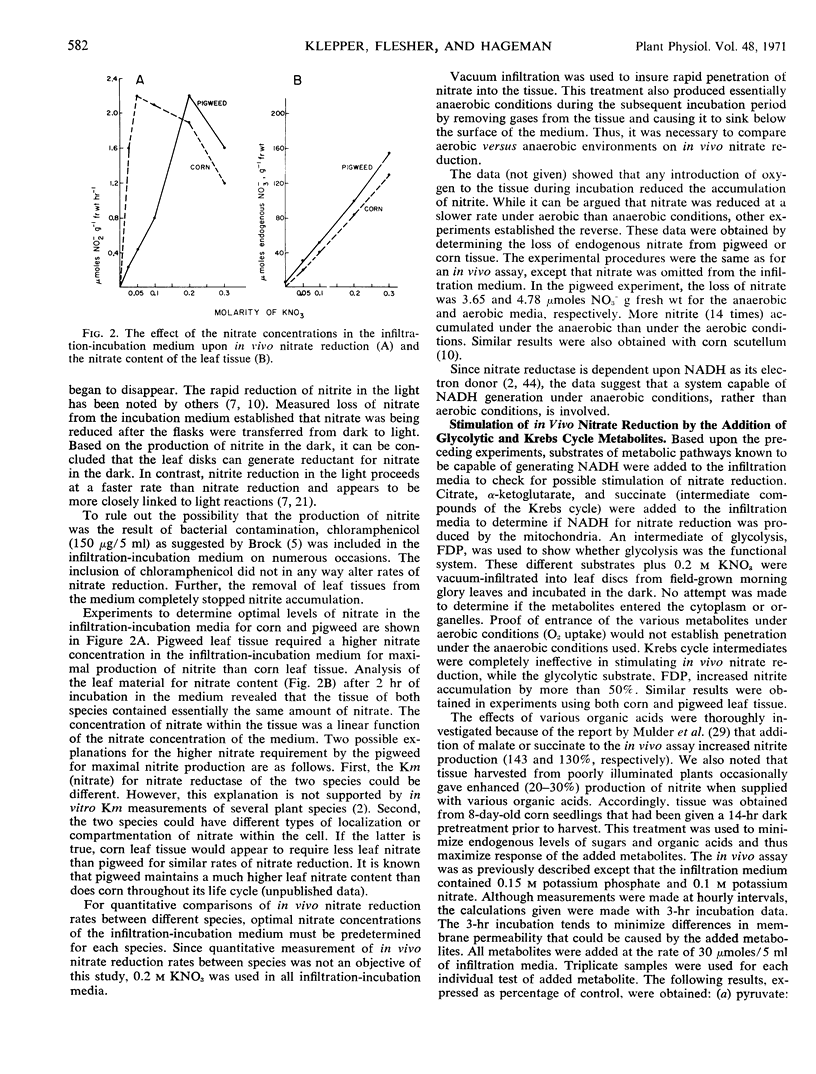
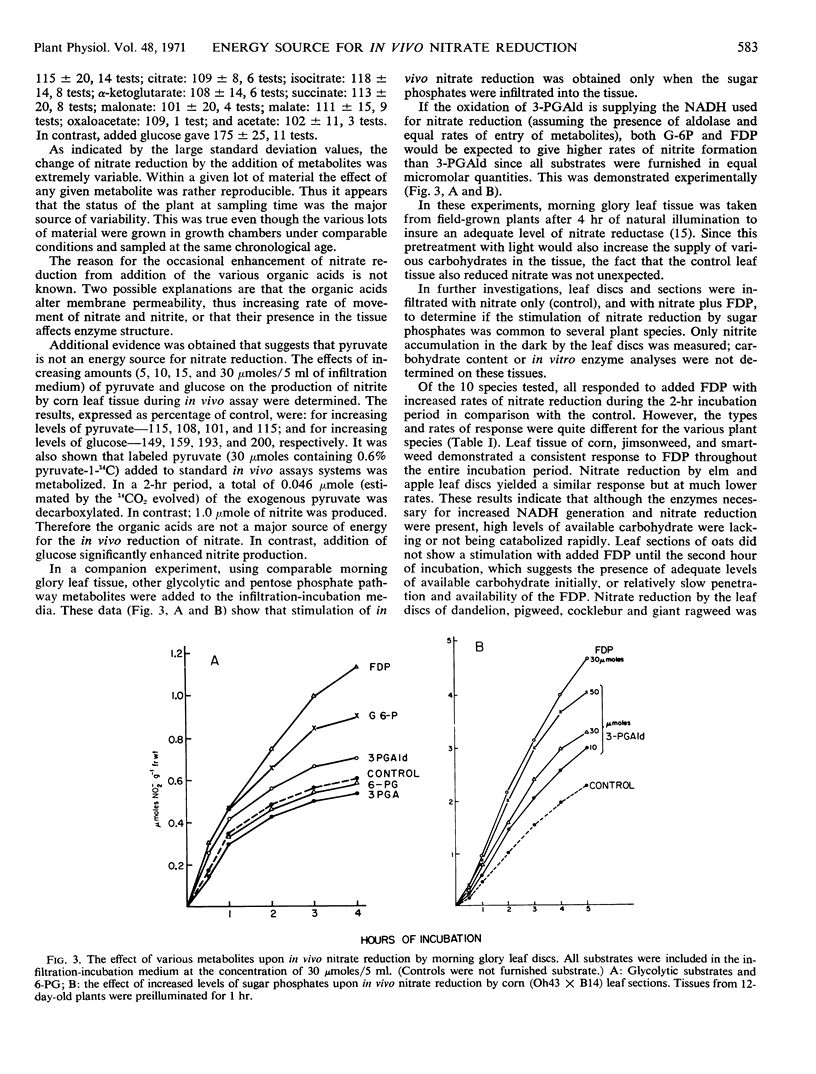


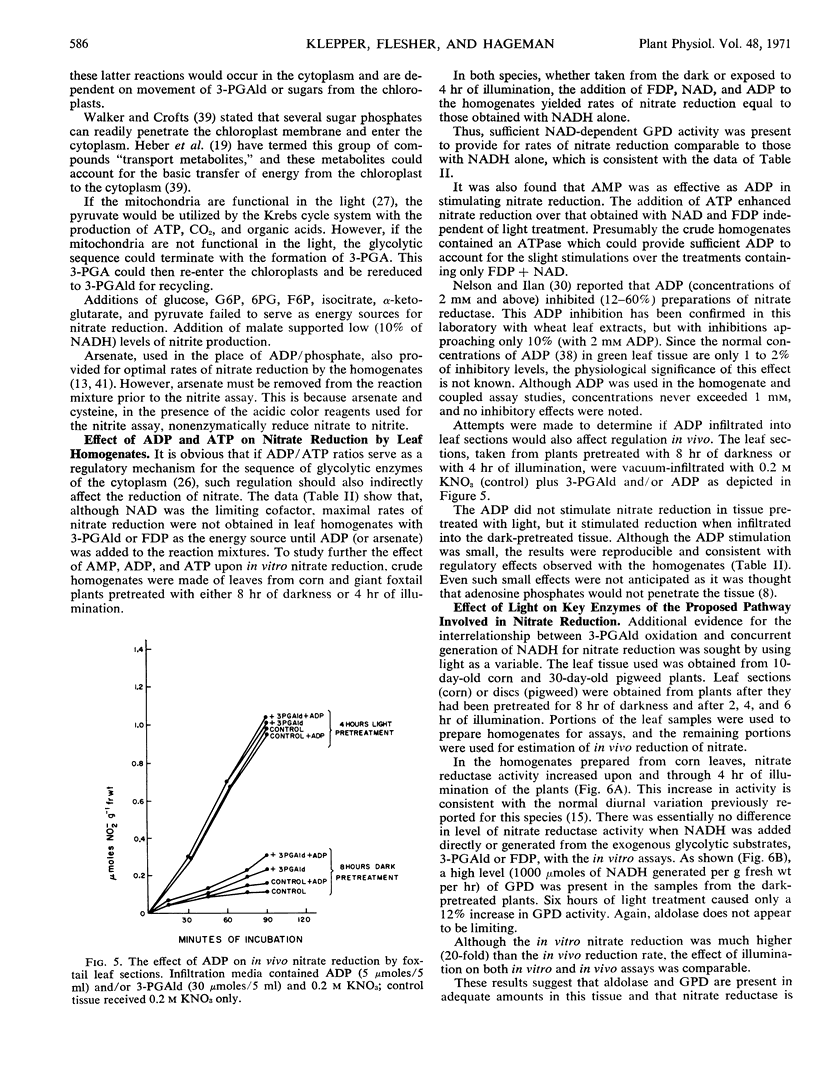
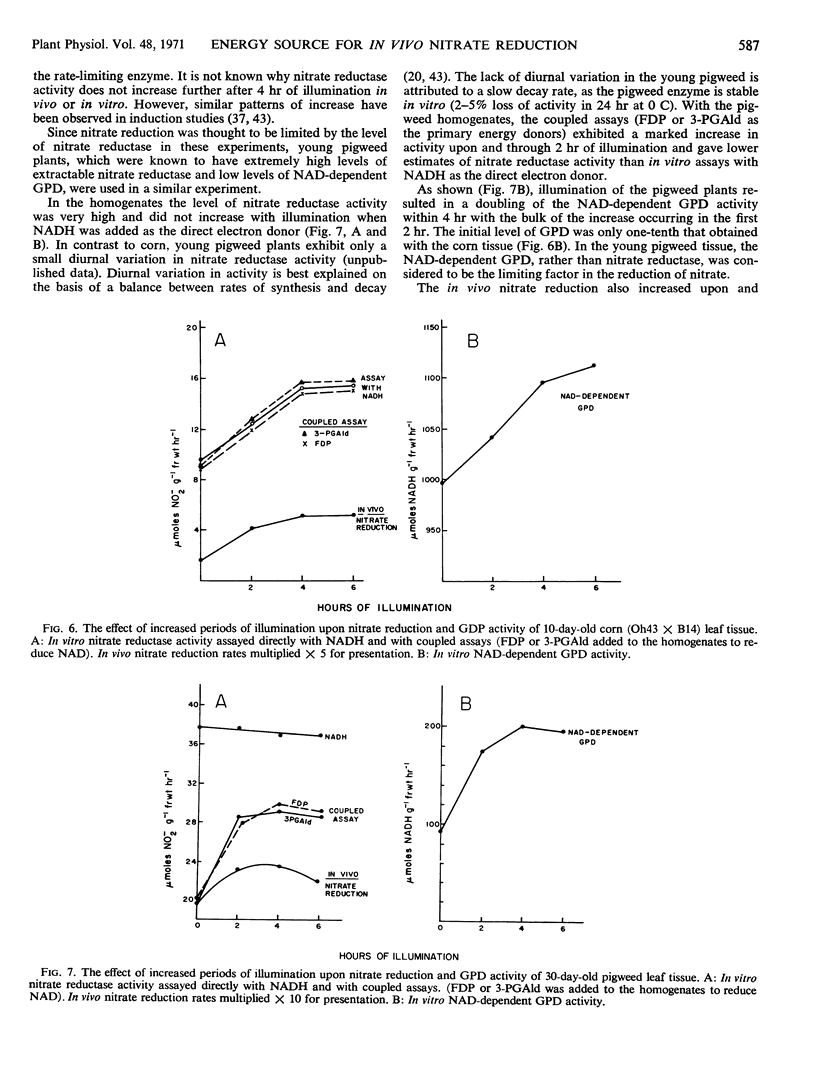
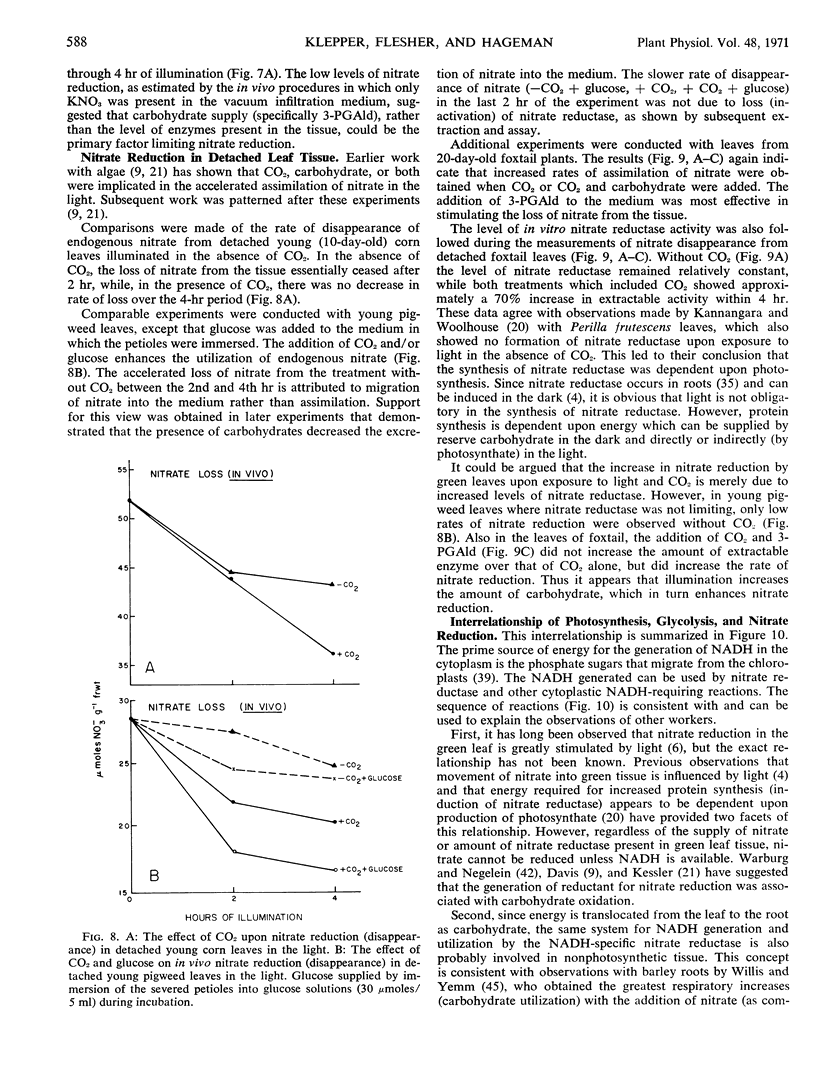


Selected References
These references are in PubMed. This may not be the complete list of references from this article.
- BEEVERS L., FLESHER D., HAGEMAN R. H. STUDIES ON THE PYRIDINE NUCLEOTIDE SPECIFICITY OF NITRATE REDUCTASE IN HIGHER PLANTS AND ITS RELATIONSHIP TO SULFHYDRYL LEVEL. Biochim Biophys Acta. 1964 Sep 18;89:453–464. doi: 10.1016/0926-6569(64)90071-9. [DOI] [PubMed] [Google Scholar]
- Bassham J. A., Kirk M., Jensen R. G. Photosynthesis by isolated chloroplasts. I. Diffusion of labeled photosynthetic intermediates between isolated chloroplasts and suspending medium. Biochim Biophys Acta. 1968 Jan 15;153(1):211–218. doi: 10.1016/0005-2728(68)90162-x. [DOI] [PubMed] [Google Scholar]
- Beevers L., Schrader L. E., Flesher D., Hageman R. H. The Role of Light and Nitrate in the Induction of Nitrate Reductase in Radish Cotyledons and Maize Seedlings. Plant Physiol. 1965 Jul;40(4):691–698. doi: 10.1104/pp.40.4.691. [DOI] [PMC free article] [PubMed] [Google Scholar]
- Brock T. D. CHLORAMPHENICOL. Bacteriol Rev. 1961 Mar;25(1):32–48. doi: 10.1128/br.25.1.32-48.1961. [DOI] [PMC free article] [PubMed] [Google Scholar]
- Ferrari T. E., Varner J. E. Control of nitrate reductase activity in barley aleurone layers. Proc Natl Acad Sci U S A. 1970 Mar;65(3):729–736. doi: 10.1073/pnas.65.3.729. [DOI] [PMC free article] [PubMed] [Google Scholar]
- GRAHAM D., WALKER D. A. Some effects of light on the interconversion of metabolites in green leaves. Biochem J. 1962 Mar;82:554–560. doi: 10.1042/bj0820554. [DOI] [PMC free article] [PubMed] [Google Scholar]
- HEBER U., WILLENBRINK J. SITES OF SYNTHESIS AND TRANSPORT OF PHOTOSYNTHETIC PRODUCTS WITHIN THE LEAF CELL. Biochim Biophys Acta. 1964 Feb 10;82:313–324. doi: 10.1016/0304-4165(64)90302-2. [DOI] [PubMed] [Google Scholar]
- Hageman R. H., Flesher D. Nitrate Reductase Activity in Corn Seedlings as Affected by Light and Nitrate Content of Nutrient Media. Plant Physiol. 1960 Sep;35(5):700–708. doi: 10.1104/pp.35.5.700. [DOI] [PMC free article] [PubMed] [Google Scholar]
- Hageman R. H., Waygood E. R. Methods for the Extraction of Enzymes from Cereal Leaves with Especial Reference to the Triosephosphate Dehydrogenases. Plant Physiol. 1959 Jul;34(4):396–400. doi: 10.1104/pp.34.4.396. [DOI] [PMC free article] [PubMed] [Google Scholar]
- Heber U. W., Santarius K. A. Compartmentation and reduction of pyridine nucleotides in relation to photosynthesis. Biochim Biophys Acta. 1965 Nov 29;109(2):390–408. doi: 10.1016/0926-6585(65)90166-4. [DOI] [PubMed] [Google Scholar]
- Heber U., Pon N. G., Heber M. Localization of Carboxydismutase & Triosephosphate Dehydrogenases in Chloroplasts. Plant Physiol. 1963 May;38(3):355–360. doi: 10.1104/pp.38.3.355. [DOI] [PMC free article] [PubMed] [Google Scholar]
- Klepper L., Hageman R. H. The occurrence of nitrate reductase in apple leaves. Plant Physiol. 1969 Jan;44(1):110–114. doi: 10.1104/pp.44.1.110. [DOI] [PMC free article] [PubMed] [Google Scholar]
- MENDEL J. L., VISSER D. W. Studies on nitrate reduction in higher plants. I. Arch Biochem Biophys. 1951 Jun;32(1):158–169. doi: 10.1016/0003-9861(51)90249-4. [DOI] [PubMed] [Google Scholar]
- Marsh H. V., Galmiche J. M., Gibbs M. Effect of Light on the Tricarboxylic Acid Cycle in Scenedesmus. Plant Physiol. 1965 Nov;40(6):1013–1022. doi: 10.1104/pp.40.6.1013. [DOI] [PMC free article] [PubMed] [Google Scholar]
- Ogren W. L., Krogmann D. W. Studies on pyridine nucleotides in photosynthetic tissue. Concentrations, interconversions, and distribution. J Biol Chem. 1965 Dec;240(12):4603–4608. [PubMed] [Google Scholar]
- Pringle R. B. Chemical constitution of the host-specific toxin of Helminthosporium carbonum. Plant Physiol. 1970 Jul;46(1):45–49. doi: 10.1104/pp.46.1.45. [DOI] [PMC free article] [PubMed] [Google Scholar]
- Ritenour G. L., Joy K. W., Bunning J., Hageman R. H. Intracellular localization of nitrate reductase, nitrite reductase, and glutamic Acid dehydrogenase in green leaf tissue. Plant Physiol. 1967 Feb;42(2):233–237. doi: 10.1104/pp.42.2.233. [DOI] [PMC free article] [PubMed] [Google Scholar]
- Sanderson G. W., Cocking E. C. Enzymic Assimilation of Nitrate in Tomato Plants. I. Reduction of Nitrate to Nitrite. Plant Physiol. 1964 May;39(3):416–422. doi: 10.1104/pp.39.3.416. [DOI] [PMC free article] [PubMed] [Google Scholar]
- Schrader L. E., Beevers L., Hageman R. H. Differential effects of chloramphenicol on the induction of nitrate and nitrite reductase in green leaf tissue. Biochem Biophys Res Commun. 1967 Jan 10;26(1):14–17. doi: 10.1016/0006-291x(67)90244-6. [DOI] [PubMed] [Google Scholar]
- Schrader L. E., Ritenour G. L., Eilrich G. L., Hageman R. H. Some characteristics of nitrate reductase from higher plants. Plant Physiol. 1968 Jun;43(6):930–940. doi: 10.1104/pp.43.6.930. [DOI] [PMC free article] [PubMed] [Google Scholar]
- Walker D. A., Crofts A. R. Photosynthesis. Annu Rev Biochem. 1970;39:389–428. doi: 10.1146/annurev.bi.39.070170.002133. [DOI] [PubMed] [Google Scholar]


